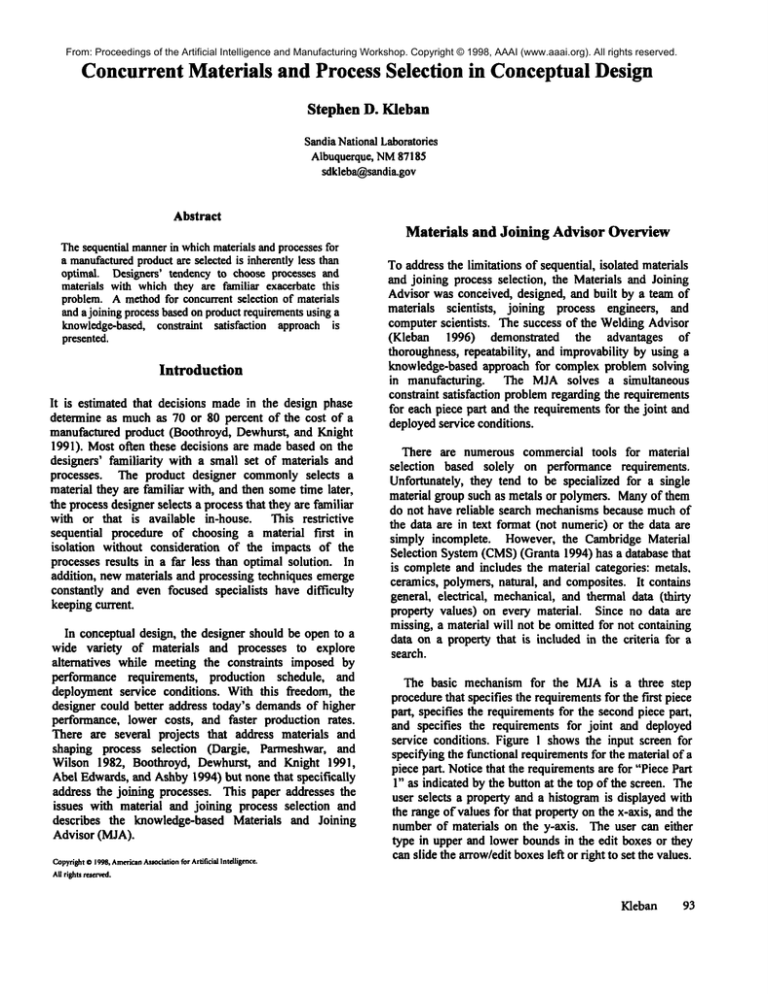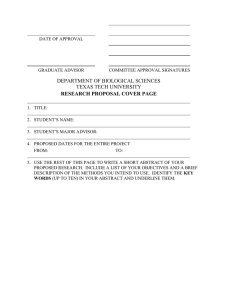
From: Proceedings of the Artificial Intelligence and Manufacturing Workshop. Copyright © 1998, AAAI (www.aaai.org). All rights reserved.
ConcurrentMaterials and Process Selection in Conceptual Design
Stephen
D. Kleban
SandiaNationalLaboratories
Albuquerque, NM87185
sdkleba~sandia.gov
Abstract
Materials
Thesequential mannerin whichmaterials and processesfor
a manufactured
productare selected is inherently less than
optimal. Designers’ tendency to choose processes and
materials with whichthey are familiar exacerbate this
problem.A methodfor concurrent selection of materials
and a joining processbasedon productrequirementsusing a
knowledge-based,constraint satisfaction approach is
presented.
Introduction
It is estimated that decisions madein the design phase
determine as much as 70 or 80 percent of the cost of a
manufactured product (Boothroyd, Dewhurst, and Knight
1991). Most often these decisions are madebased on the
designers’ familiarity with a small set of materials and
processes. The product designer commonlyselects a
material they arc familiar with, and then sometime later,
the process designer selects a process that they are familiar
with or that is available in-house. This restrictive
sequential procedure of choosing a material first in
isolation without consideration of the impacts of the
processes results in a far less than optimal solution. In
addition, new materials and processing techniques emerge
constantly and even focused specialists have difficulty
keeping current.
In conceptual design, the designer should be open to a
wide variety of materials and processes to explore
alternatives while meeting the constraints imposed by
performance requirements, production schedule, and
deployment service conditions. With this freedom, the
designer could better address today’s demandsof higher
performance, lower costs, and faster production rates.
There are several projects that address materials and
shaping process selection (Dargie, Parmeshwar, and
Wilson 1982, Boothroyd, Dewhurst, and Knight 1991,
Abel Edwards, and Ashby1994) but none that specifically
address the joining processes. This paper addresses the
issues with material and joining process selection and
describes the knowledge-based Materials and Joining
Advisor (MJA).
Cop/right0 1998,American
Association
for Artificial Intdligence.
AHrights reserved.
and Joining
Advisor
Overview
To address the limitations of sequential, isolated materials
and joining process selection, the Materials and Joining
Advisor was conceived, designed, and built by a team of
materials scientists,
joining process engineers, and
computer scientists. The success of the Welding Advisor
(Kleban 1996) demonstrated
the advantages
thoroughness, repeatability, and improvability by using a
knowledge-based approach for complex problem solving
in manufacturing. The MJAsolves a simultaneous
constraint satisfaction problemregarding the requirements
for each piece part and the requirements for the joint and
deployed service conditions.
There are numerous commercial tools for material
selection based solely on performance requirements.
Unfortunately, they tend to be specialized for a single
material group such as metals or polymers. Manyof them
do not have reliable search mechanismsbecause muchof
the data are in text format (not numeric) or the data are
simply incomplete. However, the Cambridge Material
Selection System (CMS)(Granta 1994) has a database
is complete and includes the material categories: metals.
ceramics, polymers, natural, and composites. It contains
general, electrical, mechanical, and thermal data (thirty
property values) on every material. Since no data are
missing, a material will not be omitted for not containing
data on a property that is included in the criteria for a
search.
The basic mechanism for the MJAis a three step
procedurethat specifies the requirementsfor the first piece
part, specifies the requirements for the secondpiece part,
and specifies the requirements for joint and deployed
service conditions. Figure I shows the input screen for
specifying the functional requirementsfor the material of a
piece part. Notice that the requirementsare for "Piece Part
1" as indicated by the button at the top of the screen. The
user selects a property and a histogram is displayed with
the range of values for that property on the x-axis, and the
number of materials on the y-axis. The user can either
type in upper and lower boundsin the edit boxes or they
can slide the arrow/edit boxesleft or right to set the values.
Kleban
93
From: Proceedings of the Artificial Intelligence and Manufacturing Workshop. Copyright
© 1998,
AAAI (www.aaai.org).
All rights reserved.
including:
composition,
all the property
values, suppliers,
¯ " ""
-’~
.
. " J4omlcVolume(msrage)
i ..,J.. Dens~
z
¯ .JL_~_.’
..........
~.............._~ -
typical uses, etc. A red check mark indicates that a
material is selected for consideration. As shownin Figure
2, both 6061-T4 and 6061-T6 are selected as options for
"Piece Part 2".
...ri~_~..cal
.I I I I I I I I.
¯....L+~......-Iv
.. .I l I l ~ l I i l i I
IJb
...
.............
.
::-:
l~lUn~r~,
.....
~ II I
4m~OJ
1970
4t
m~+alcWs~m~tmmde~
I I r "" .. n o
I "
"-I
’++"°°’"°’"
.... ’ ’
.401iS
i
I
’
Figure 1. The screen for specifying bounds on material
properties. In this example, a hard, highly resistive,
relatively inexpensivematerial is required.
"7~"- ’"~’"
lash.,.-]
Id’lUr~aW~r.m~d~t’~4w ¯ ."
Setting upper and lower boundsfor properties results in
a set of materials that fall with that range. The numberof
materials that fall within the specified range is displayedat
the bottom of the histogram. This process of setting
property values can be repeated for a numberof properties,
each time resulting in a new set of materials for each
bounded property. Following the convention of CMS,the
"SoFar" button performs the intersection of these sets to
determine if we are in a reasonable search dimensionor if
no materials satisfy the requirements and we are specifying
"unobtainiumt". This part of the MJA,in and of itself,
provides a useful methodfor material selection.
’-.. "; ~"~i.
¯.~-~,~,~r~,,,~,,~’l:.~.. ~
~i
~’~ "...
! ;~L-Z ".. ¯ "l’
..
_
Figure 2. The materials hierarchy. The user specified
aluminum 6061-1"4 or 6061-T6 as material options for
"Piece Part 2".
Once the requirements for "Piece Part l" (hard, high
resistance, cheap) and "Piece Part 2" (AI-6061-T4or AI6061-T6)are in place, the final constraint specifications
are for the joint and the deployed service conditions. As
shownin Figure 3, the user inputs parameterspertaining to
Purpose, Service Loading, Service Environment,etc.
Once the user is satisfied with the specification of
"Piece Part !" they repeat the procedurefor "Piece Part 2".
Notice in Figure I the "Both Parts" check box is checked
for the Hardness property. This is a convenience for the
user so that they do not have to re-enter the property
constraints twice if they pertain to both piece parts.
An alternative scenario may be that the material for
"Piece Part 2" is knownand the material selection for
"’Piece part 1" is open. To anchor "Piece Part 2" to a
specific material, the user clicks on the "Materials" button
at the top of the screen for "Piece Part 2". A material
hierarchy is displayed where the user can manually browse
the hierarchy or they can perform a search for a particular
material. Oncethe material is located in the hierarchy, the
"Details" button to the right of the material can be pressed
to display a wealth of information about the material
u Manufacturingslang for a set of requirementsthat is so
restrictive that no existing materialcan satisfy it.
94
AIMW-98
Figure 3. Constraints for the joint and deployed service
conditions.
From:
Proceedings
the Artificial
Intelligence
and Manufacturing
Workshop. Copyright © 1998, AAAI (www.aaai.org). All rights reserved.
In addition,
theofuser
can specify
to match
the Thermal
ExpansionCoefficientof the twomaterials withina certain
percent and/or to match the Thermal Expansion
Coefficient multiplied by the Bulk Modulus(a measureof
stress) within a certain percent. In this example,the
ThermalExpansionCoefficient is matchedwithin 15%and
the ThermalExpansionCoefficient multiplied by the Bulk
Modulusis matchedwithin 20%.
.....-.-.-.
~iiiiiiiiii
:..........
MMerliil I~rlol2
Process
8¢orll
I.o84 Env Ternp ~
Knowledge-based Constraint Satisfaction
With all the constraints nowspecified, the task of
simultaneously
satisfying the constraints is presentedto the
knowledge-based advisor. The joining processes it
evaluatesare welding,soldering, brazing,adhesives,glaze
bonding, diffusion bonding, and mechanicalfastening.
Initially, muchof the workdoneby the advisor is database
search,retrieving materialsthat satisfy the constraintsfor
each of the piece parts. Whenthe database search is
completed, all combinations of materials and joining
processscenariosare generated.
Maximum
numberof joining scenarios equals
x -y -z where
x = size of set of materialssatisfying constraintsfor piece
part 1,
y = size of set of materialssatisfying constraintsfor piece
part 2,
z = maxnumberof joining process options = 7.
In fact, not all possiblecombinations
are generated.The
advisor has the intelligence not to proposescenarios that
are totally infeasible. It knows,for example,not to join a
ceramic to a polymer by welding. Finally, the advisor
attempts to satisfy the constraints imposedon the joint
(e.g. joint purpose, analyzing the thermal fluctuation
impacts, etc) and by the deployedservice conditions. The
results are displayedas a scoredandrankedorderedtable
of results as shownin Figure4.
Eachrowin the table is a possiblescenariofor materials
and process selection. Anexplanation of the reasoning
process and the determination of score and rank are
available for everyscenario by clicking on the particular
scenario in the table. There are four recommended
scenarios in this example, as indicated by the light
background(green) color for rowsI - 4. All others have
failed a majorrequirementas indicated by the dark (red)
color.
Figure 4. Thetable of results for material selection for
eachpiecepart andfor selectionof a joiningprocess.
Architecture
TheMJAis implemented
as a three tier architecture. R is
entirely implemented
using JavaTM technology.Theclient
(Java applet) is downloaded
froma webserver to the web
browseron the desktopof the user. It communicates
back
to the server (Java application) using Java’s RMI
distributed object communication
mechanism.
The server,
which encompassesthe knowledgebase, accesses the
materials database through Java’s JDBCrelational
database access protocol. Thedatabaseis implemented
in
Sybase®SQLAnywhere.
Benefits
Oneindisputable benefit fromthe MJAis timesaving.For
a materials scientist to research all material categories
(metals, ceramics,polymers,composites,and natural) for
applicablematerials basedon functional requirementsof a
part can be quite time consuming.In addition, performing
the thermal expansion and stress analysis potentially
increasesthe time by an order of magnitude.
The simultaneous materials and joining process
selection methodallows for a muchbetter solution than
performingeither of these in isolation fast. A "good"
material and a "good" process is muchbetter than an
"excellent" material and a "poor"processor "no"process
anda trip backto the drawingboard.Also, consideringthe
entire materials kingdom
allowsfor novel material usage,
pushingthe designer to look beyondtheir narrowset of
habitual options. This methodof simultaneousmaterials
Kleban
95
From:
Proceedings
of the Artificial
and
Manufacturing
Workshop. Copyright
© 1998, AAAI
rights
and
process selection
can Intelligence
be no worse
than
its sequential
G. Boothroyd,
P. (www.aaai.org).
Dewhurst andAllW.
A. reserved.
Knight,
counterpart.
Furthermore, the thorough and repeatable process of
simultaneous material and process selection is mucheasier
for a computer to perform than a human.Database lookup
is much faster and thorough than a set of materials
handbookson a shelf. Of course, the experts will always
have gems of knowledge that the MJAdoes not, but the
knowledge in the MJAcan constantly be updated and
improved. The simultaneous considerations
of all
materials and all joining processes allows for product
performance optimization, innovation, cost and schedule
improvements,and better response to forces of change.
Future
Work
Workhas begun on developing a Materials and Process
Design Environment (MPDE) of which the MJAis
portion. The MPDEvision is to have an integrated
environmentwhere all the tools share information under a
common ontology. This way, the Shaping Advisor
(Rivera, Stubblefield, and Ames1997) communicateswith
the Materials and Joining Advisor, which in turn
communicates with the Welding Advisor. The workspace
of information that is continually modified is accessed and
sharedby all.
Morespecifically for the MJA,work is planned to build
a multi-base architecture so that a numberof materials
databases can be queried simultaneously including inhouse, proprietary materials data. Somethought has also
been given to a fuzzy logic approach for materials
constraint satisfaction. Finally, general performance
measures, such as "light and stiff," may be added for
easier, moreintuitive material constraint specification.
Acknowledgements
The author acknowledges the program support and
direction of Louie Tallerico and John Mitchiner, the team
of experts including Jerry Knorovsky, Brian Damkroger,
Sandy Monroe. Doug Adolf, Gary Pressly, and design
issues discussions with Bill Stubblefield. This work was
performed at Sandia National Laboratories supported by
the U.S. Department of Energy under contract numbers
DE-AC04-76DP00789 and DE-AC04-94AL85000.
References
C. A. Abel, K. L. Edwards and M. F. Ashby, 1994.
Materials, processing and the environment in engineering
design: the issues. Materials &Design 15(4): 179-193.
96
AIMW-98
1991.
Research program on the Seiction pf Materials and
Processes for ComponentParts. International Journal of
Advanced Manufacturing Technologies. 6:98-1 ! I,
London: Springer-Verlag.
P. P. Dargie, K. Parmeshwarand W. R. D. Wilson. 1982.
MAPS-l: computer-aided design system for preliminary
material and manufacturing selection. ASME
Transactions
104:126-136.
Granta 1994. Granta Design Limited, 20 Trumpington
Street, Cambridge CB21QA, United Kingdom.
S. D. Kleban, 1996. Design Issues of a Knowledge-based
WeldingAdvisor. Proceedings Artificial Intelligence and
Manufacturing Research Planning Workshop, 98-102.
Albuquerque, NewMexico: AAAIPress.
J. J. givera, W. A. Stubblefieid, and A. L. Ames1996.
Critics
and Advisors: Heuristic
Knowledge and
Manufacturability. ProceedingsArtificial Intelligence and
Manufacturing Research Planning Workshop, 146-152.
Albuquerque, NewMexico: AAAIPress.



